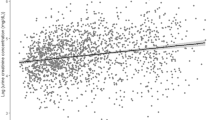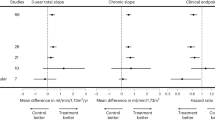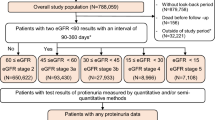Abstract
Surrogate end points of renal failure are instrumental to the testing of new treatments in patients with chronic kidney disease, the natural history of which is characterized by a slow, asymptomatic decline in renal function. The magnitude of proteinuria is widely recognized as a marker of the severity of glomerulopathy. Population-based studies have identified proteinuria as a predictor of future decline in glomerular filtration rate and of the development of end-stage renal disease. More importantly, a reduction in proteinuria invariably translates into a protection from renal function decline in patients with diabetic and nondiabetic renal disease with overt proteinuria. Thus, proteinuria should be considered a valuable surrogate end point for clinical trials in patients with proteinuric renal diseases.
This is a preview of subscription content, access via your institution
Access options
Subscribe to this journal
Receive 12 print issues and online access
$209.00 per year
only $17.42 per issue
Buy this article
- Purchase on Springer Link
- Instant access to full article PDF
Prices may be subject to local taxes which are calculated during checkout


Similar content being viewed by others
References
United States Renal Data System Annual Data Report. United States Renal Data System [online], (2010).
Ruggenenti, P. & Remuzzi, G. Kidney failure stabilizes after a two-decade increase: impact on global (renal and cardiovascular) health. Clin. J. Am. Soc. Nephrol. 2, 146–150 (2007).
Cravedi, P., Ruggenenti, P. & Remuzzi, G. Kidney failure stabilizes after an increase over 2 decades. J. Ren. Care 33, 100–104 (2007).
Piantadosi, S. Clinical Trials: a Methodologic Perspective (John Wiley and Sons, New York, 1997).
Waller, K. V., Ward, K. M., Mahan, J. D. & Wismatt, D. K. Current concepts in proteinuria. Clin. Chem. 35, 755–765 (1989).
Kim, M. S. Proteinuria. Clin. Lab. Med. 8, 527–540 (1988).
Ruggenenti, P. & Remuzzi, G. Time to abandon microalbuminuria? Kidney Int. 70, 1214–1222 (2006).
Gerstein, H. C. et al. Albuminuria and risk of cardiovascular events, death, and heart failure in diabetic and nondiabetic individuals. JAMA 286, 421–426 (2001).
Wachtell, K. et al. Albuminuria and cardiovascular risk in hypertensive patients with left ventricular hypertrophy: the LIFE study. Ann. Intern. Med. 139, 901–906 (2003).
Adler, A. I. et al. Development and progression of nephropathy in type 2 diabetes: the United Kingdom Prospective Diabetes Study (UKPDS 64). Kidney Int. 63, 225–232 (2003).
Lemley, K. V. et al. Glomerular permselectivity at the onset of nephropathy in type 2 diabetes mellitus. J. Am. Soc. Nephrol. 11, 2095–2105 (2000).
Bazzi, C., Petrini, C., Rizza, V., Arrigo, G. & D'Amico, G. A modern approach to selectivity of proteinuria and tubulointerstitial damage in nephrotic syndrome. Kidney Int. 58, 1732–1741 (2000).
Remuzzi, G., Benigni, A. & Remuzzi, A. Mechanisms of progression and regression of renal lesions of chronic nephropathies and diabetes. J. Clin. Invest. 116, 288–296 (2006).
Pavkov, M. E. et al. Early renal function decline in type 2 diabetes. Clin. J. Am. Soc. Nephrol. 7, 78–84 (2012).
Ruggenenti, P. & Remuzzi, G. Angiotensin-converting enzyme inhibitor therapy for non-diabetic progressive renal disease. Curr. Opin. Nephrol. Hypertens. 6, 489–495 (1997).
Barnes, J. L. & Gorin, Y. Myofibroblast differentiation during fibrosis: role of NAD(P)H oxidases. Kidney Int. 79, 944–956 (2011).
Zoja, C. et al. Proximal tubular cell synthesis and secretion of endothelin-1 on challenge with albumin and other proteins. Am. J. Kidney Dis. 26, 934–941 (1995).
Drumm, K., Bauer, B., Freudinger, R. & Gekle, M. Albumin induces NF-kappaB expression in human proximal tubule-derived cells (IHKE-1). Cell Physiol. Biochem. 12, 187–196 (2002).
Tang, S. et al. Albumin stimulates interleukin-8 expression in proximal tubular epithelial cells in vitro and in vivo. J. Clin. Invest. 111, 515–527 (2003).
Abbate, M., Zoja, C. & Remuzzi, G. How does proteinuria cause progressive renal damage? J. Am. Soc. Nephrol. 17, 2974–2984 (2006).
Rudnicki, M. et al. Gene expression profiles of human proximal tubular epithelial cells in proteinuric nephropathies. Kidney Int. 71, 325–335 (2007).
Johnson, D. W., Saunders, H. J., Baxter, R. C., Field, M. J. & Pollock, C. A. Paracrine stimulation of human renal fibroblasts by proximal tubule cells. Kidney Int. 54, 747–757 (1998).
Biancone, L. et al. Alternative pathway activation of complement by cultured human proximal tubular epithelial cells. Kidney Int. 45, 451–460 (1994).
Nangaku, M., Pippin, J. & Couser, W. G. Complement membrane attack complex (C5b-9) mediates interstitial disease in experimental nephrotic syndrome. J. Am. Soc. Nephrol. 10, 2323–2331 (1999).
Rangan, G. K., Pippin, J. W., Coombes, J. D. & Couser, W. G. C5b-9 does not mediate chronic tubulointerstitial disease in the absence of proteinuria. Kidney Int. 67, 492–503 (2005).
Iseki, K., Iseki, C., Ikemiya, Y. & Fukiyama, K. Risk of developing end-stage renal disease in a cohort of mass screening. Kidney Int. 49, 800–805 (1996).
Ruggenenti, P. et al. Proteinuria predicts end-stage renal failure in non-diabetic chronic nephropathies. The “Gruppo Italiano di Studi Epidemiologici in Nefrologia” (GISEN). Kidney Int. Suppl. 63, S54–S57 (1997).
Ruggenenti, P., Perna, A., Mosconi, L., Pisoni, R. & Remzzi, G. Urinary protein excretion rate is the best independent predictor of ESRF in non-diabetic proteinuric chronic nephropathies. “Gruppo Italiano di Studi Epidemiologici in Nefrologia” (GISEN). Kidney Int. 53, 1209–1216 (1998).
Peterson, J. C. et al. Blood pressure control, proteinuria, and the progression of renal disease. The Modification of Diet in Renal Disease study. Ann. Intern. Med. 123, 754–762 (1995).
Wright, J. T. Jr et al. Effect of blood pressure lowering and antihypertensive drug class on progression of hypertensive kidney disease: results from the AASK trial. JAMA 288, 2421–2431 (2002).
Retnakaran, R., Cull, C. A., Thorne, K. I., Adler, A. I. & Holman, R. R. Risk factors for renal dysfunction in type 2 diabetes: U. K. Prospective Diabetes Study 74. Diabetes 55, 1832–1839 (2006).
Keane, W. F. et al. Risk scores for predicting outcomes in patients with type 2 diabetes and nephropathy: the RENAAL study. Clin. J. Am. Soc. Nephrol. 1, 761–767 (2006).
Atkins, R. C. et al. Proteinuria reduction and progression to renal failure in patients with type 2 diabetes mellitus and overt nephropathy. Am. J. Kidney Dis. 45, 281–287 (2005).
de Zeeuw, D. et al. Renal risk and renoprotection among ethnic groups with type 2 diabetic nephropathy: a post hoc analysis of RENAAL. Kidney Int. 69, 1675–1682 (2006).
Remuzzi, G. & Bertani, T. Pathophysiology of progressive nephropathies. N. Engl. J. Med. 339, 1448–1456 (1998).
Group, T. G. Randomised placebo-controlled trial of effect of ramipril on decline in glomerular filtration rate and risk of terminal renal failure in proteinuric, non-diabetic nephropathy. Lancet 349, 1857–1863 (1997).
Ruggenenti, P., Perna, A. & Remuzzi, G. Retarding progression of chronic renal disease: the neglected issue of residual proteinuria. Kidney Int. 63, 2254–2261 (2003).
Bjorck, S., Mulec, H., Johnsen, S. A., Norden, G. & Aurell, M. Renal protective effect of enalapril in diabetic nephropathy. BMJ 304, 339–343 (1992).
Lewis, E. J., Hunsicker, L. G., Bain, R. P. & Rohde, R. D. The effect of angiotensin-converting-enzyme inhibition on diabetic nephropathy. The Collaborative Study Group. N. Engl. J. Med. 329, 1456–1462 (1993).
Jafar, T. H. et al. Angiotensin-converting enzyme inhibitors and progression of nondiabetic renal disease. A meta-analysis of patient-level data. Ann. Intern. Med. 135, 73–87 (2001).
Ruggenenti, P., Schieppati, A. & Remuzzi, G. Progression, remission, regression of chronic renal diseases. Lancet 357, 1601–1608 (2001).
Vegter, S. et al. Sodium Intake, ACE Inhibition, and Progression to ESRD. J. Am. Soc. Nephrol. 23, 165–173 (2012).
Campbell, R. et al. Effects of combined ACE inhibitor and angiotensin II antagonist treatment in human chronic nephropathies. Kidney Int. 63, 1094–1103 (2003).
Hovind, P. et al. Remission of nephrotic-range albuminuria in type 1 diabetic patients. Diabetes Care 24, 1972–1977 (2001).
de Zeeuw, D. et al. Albuminuria, a therapeutic target for cardiovascular protection in type 2 diabetic patients with nephropathy. Circulation 110, 921–927 (2004).
Ruggenenti, P. et al. Effects of verapamil added-on trandolapril therapy in hypertensive type 2 diabetes patients with microalbuminuria: the BENEDICT-B randomized trial. J. Hypertens. 29, 207–216 (2011).
Schmieder, R. E. et al. Changes in albuminuria predict mortality and morbidity in patients with vascular disease. J. Am. Soc. Nephrol. 22, 1353–1364 (2011).
Sandhu, S., Wiebe, N., Fried, L. F. & Tonelli, M. Statins for improving renal outcomes: a meta-analysis. J. Am. Soc. Nephrol. 17, 2006–2016 (2006).
Conley, J., Olafsson, A. & Djamali, A. Do statins delay the incidence of ESRD in diabetic patients with moderate CKD? J. Nephrol. 23, 321–327 (2010).
Ruggenenti, P. et al. Effects of add-on fluvastatin therapy in patients with chronic proteinuric nephropathy on dual renin-angiotensin system blockade: The ESPLANADE Trial. Clin. J. Am. Soc. Nephrol. 5, 1928–1938 (2010).
Zoja, C. et al. How to fully protect the kidney in a severe model of progressive nephropathy: a multidrug approach. J. Am. Soc. Nephrol. 13, 2898–2908 (2002).
Ruggenenti, P. et al. Role of remission clinics in the longitudinal treatment of CKD. J. Am. Soc. Nephrol. 19, 1213–1224 (2008).
Ruggenenti, P. et al. Preventing microalbuminuria in type 2 diabetes. N. Engl. J. Med. 351, 1941–1951 (2004).
Nielsen, S. E. et al. Neutrophil gelatinase-associated lipocalin (NGAL) and kidney injury molecule 1 (KIM1) in patients with diabetic nephropathy: a cross-sectional study and the effects of lisinopril. Diabet. Med. 27, 1144–1150 (2010).
Nielsen, S. E. et al. Urinary liver-type fatty acid-binding protein predicts progression to nephropathy in type 1 diabetic patients. Diabetes Care 33, 1320–1324 (2010).
Nielsen, S. E. et al. Tubular markers do not predict the decline in glomerular filtration rate in type 1 diabetic patients with overt nephropathy. Kidney Int. 79, 1113–1118 (2011).
Levey, A. S. et al. Proteinuria as a surrogate outcome in CKD: report of a scientific workshop sponsored by the National Kidney Foundation and the US Food and Drug Administration. Am. J. Kidney Dis. 54, 205–226 (2009).
Xie, D., Hou, F. F., Fu, B. L., Zhang, X. & Liang, M. High level of proteinuria during treatment with renin-angiotensin inhibitors is a strong predictor of renal outcome in nondiabetic kidney disease. J. Clin. Pharmacol. 51, 1025–1034 (2011).
Lea, J. et al. The relationship between magnitude of proteinuria reduction and risk of end-stage renal disease: results of the African American study of kidney disease and hypertension. Arch. Intern. Med. 165, 947–953 (2005).
de Zeeuw, D. et al. Proteinuria, a target for renoprotection in patients with type 2 diabetic nephropathy: lessons from RENAAL. Kidney Int. 65, 2309–2320 (2004).
Hunsicker, L. G. et al. Impact of irbesartan, blood pressure control, and proteinuria on renal outcomes in the Irbesartan Diabetic Nephropathy Trial. Kidney Int. Suppl. 92, S99–S101 (2004).
Hellemons, M. E. et al. Initial angiotensin receptor blockade-induced decrease in albuminuria is associated with long-term renal outcome in type 2 diabetic patients with microalbuminuria: a post hoc analysis of the IRMA-2 trial. Diabetes Care 34, 2078–2083 (2011).
Holtkamp, F. A. et al. Albuminuria and blood pressure, independent targets for cardioprotective therapy in patients with diabetes and nephropathy: a post hoc analysis of the combined RENAAL and IDNT trials. Eur. Heart J. 32, 1493–1499 (2011).
Author information
Authors and Affiliations
Contributions
The authors contributed equally to all aspects of the manuscript.
Corresponding author
Ethics declarations
Competing interests
The authors declare no competing financial interests.
Rights and permissions
About this article
Cite this article
Cravedi, P., Ruggenenti, P. & Remuzzi, G. Proteinuria should be used as a surrogate in CKD. Nat Rev Nephrol 8, 301–306 (2012). https://doi.org/10.1038/nrneph.2012.42
Published:
Issue Date:
DOI: https://doi.org/10.1038/nrneph.2012.42
This article is cited by
-
Sex differences in impact of cumulative systolic blood pressure from childhood to adulthood on albuminuria in midlife: a 30-year prospective cohort study
BMC Public Health (2023)
-
Nephrons, podocytes and chronic kidney disease: Strategic antihypertensive therapy for renoprotection
Hypertension Research (2023)
-
Mitochondrial DNA copy number is associated with incident chronic kidney disease and proteinuria in the AIDS linked to the intravenous experience cohort
Scientific Reports (2023)
-
The interval between the onset of increased blood pressure and proteinuria in preeclampsia and the contributing factors
Archives of Gynecology and Obstetrics (2023)
-
The E3 ubiquitin ligase TRIM31 plays a critical role in hypertensive nephropathy by promoting proteasomal degradation of MAP3K7 in the TGF-β1 signaling pathway
Cell Death & Differentiation (2022)



